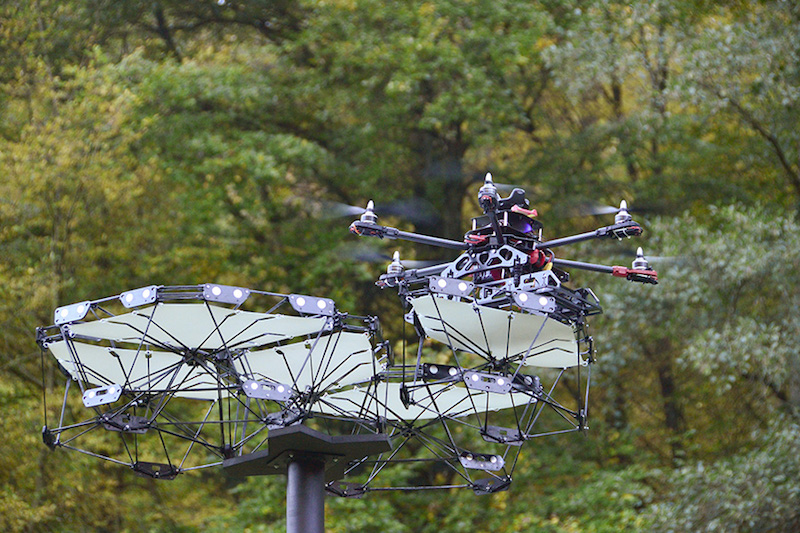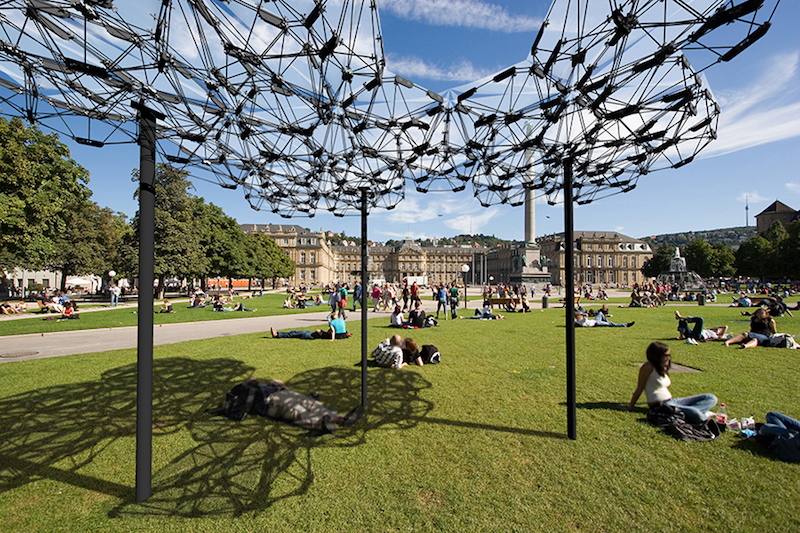Architecture is always evolving. Be it the way buildings are designed, the processes by which they are built, or the materials used. But a new prototype from the University of Stuttgart takes this continuous evolution to a new level, with a reconfigurable canopy system for public spaces that is in a state of perpetual construction.
The Cyber Physical Macro Material as a UAV [re]Configurable Architectural System (hopefully the name will continue to evolve as well) combines cyber-physical building material constructed from lightweight carbon fiber filament with integrated electronics for communication and sensing, with a collection of autonomous aerial vehicles, dubbed builders.

The canopy is composed of individual pieces that measure 40 cm wide, 64 cm long, and 25 cm tall. Each piece is composed of a roof plate that acts as the shading element, an attachment bar for UAV transport, ABS attachment plates with embedded magnets, an electronic board with a microchip, a sensor for external data input, and elements that allow each unit to communicate with every other unit.
See Also: When pigs fly? How about when cows float?
These units communicate with the UAV builders to facilitate the canopy’s movement. Separate vertical zones allow for simultaneous construction and use. This means the builders will be busy overhead changing the structure while users can still enjoy the space beneath. When the builders are not in use, they retreat to a nearby building rooftop.

This combination of distributed robotic construction and programmable matter allows for the canopy system to constantly evolve based on its surroundings. The system can be programmed with responsive behaviors, such as following the sun’s orientation to maintain a constant shadow area, or with interactive behavior, which means the user can place columns as an interface to inform the structure where to grow.
The system can also be set to probe the environment for data to develop and learn new behaviors; after time, the system will be able to predict user behavior and change to a relevant configuration in advance.
It remains to be seen if having a hive of drones buzzing overhead will spoil the experience for some users, or if the builders will be able to reconfigure the canopy quickly enough to keep up with how people would use a given green space. At the very least, the prototype is meant to challenge “preconceived ideas of robotic digital fabrication and sophisticated prefabrication for architecture.” Miguel Aflalo, Jingcheng Chen, and Behrooz Tahanzadeh created the prototype.

Related Stories
Design Innovation Report | Apr 27, 2023
BD+C's 2023 Design Innovation Report
Building Design+Construction’s Design Innovation Report presents projects, spaces, and initiatives—and the AEC professionals behind them—that push the boundaries of building design. This year, we feature four novel projects and one building science innovation.
Design Innovation Report | Apr 19, 2023
Reinforced concrete walls and fins stiffen and shade the National Bank of Kuwait skyscraper
When the National Bank of Kuwait first conceived its new headquarters more than a decade ago, it wanted to make a statement about passive design with a soaring tower that could withstand the extreme heat of Kuwait City, the country’s desert capital.
Design Innovation Report | Apr 19, 2023
HDR uses artificial intelligence tools to help design a vital health clinic in India
Architects from HDR worked pro bono with iKure, a technology-centric healthcare provider, to build a healthcare clinic in rural India.
3D Printing | Apr 11, 2023
University of Michigan’s DART Laboratory unveils Shell Wall—a concrete wall that’s lightweight and freeform 3D printed
The University of Michigan’s DART Laboratory has unveiled a new product called Shell Wall—which the organization describes as the first lightweight, freeform 3D printed and structurally reinforced concrete wall. The innovative product leverages DART Laboratory’s research and development on the use of 3D-printing technology to build structures that require less concrete.
Cladding and Facade Systems | Apr 5, 2023
Façade innovation: University of Stuttgart tests a ‘saturated building skin’ for lessening heat islands
HydroSKIN is a façade made with textiles that stores rainwater and uses it later to cool hot building exteriors. The façade innovation consists of an external, multilayered 3D textile that acts as a water collector and evaporator.
Transportation & Parking Facilities | Mar 23, 2023
Amsterdam debuts underwater bicycle parking facility that can accommodate over 4,000 bikes
In February, Amsterdam saw the opening of a new underwater bicycle parking facility. Located in the heart of the city—next to Amsterdam Central Station and under the river IJ (Amsterdam’s waterfront)—the facility, dubbed IJboulevard, has parking spots for over 4,000 bicycles, freeing up space on the street.
Concrete | Jan 24, 2023
Researchers investigate ancient Roman concrete to make durable, lower carbon mortar
Researchers have turned to an ancient Roman concrete recipe to develop more durable concrete that lasts for centuries and can potentially reduce the carbon impact of the built environment.
Sponsored | Resiliency | Dec 14, 2022
Flood protection: What building owners need to know to protect their properties
This course from Walter P Moore examines numerous flood protection approaches and building owner needs before delving into the flood protection process. Determining the flood resilience of a property can provide a good understanding of risk associated costs.
Giants 400 | Nov 14, 2022
4 emerging trends from BD+C's 2022 Giants 400 Report
Regenerative design, cognitive health, and jobsite robotics highlight the top trends from the 519 design and construction firms that participated in BD+C's 2022 Giants 400 Report.
AEC Tech | Apr 13, 2022
A robot automates elevator installation
Schindler—which manufactures and installs elevators, escalators, and moving walkways—has created a robot called R.I.S.E. (robotic installation system for elevators) to help install lifts in high-rise buildings.















